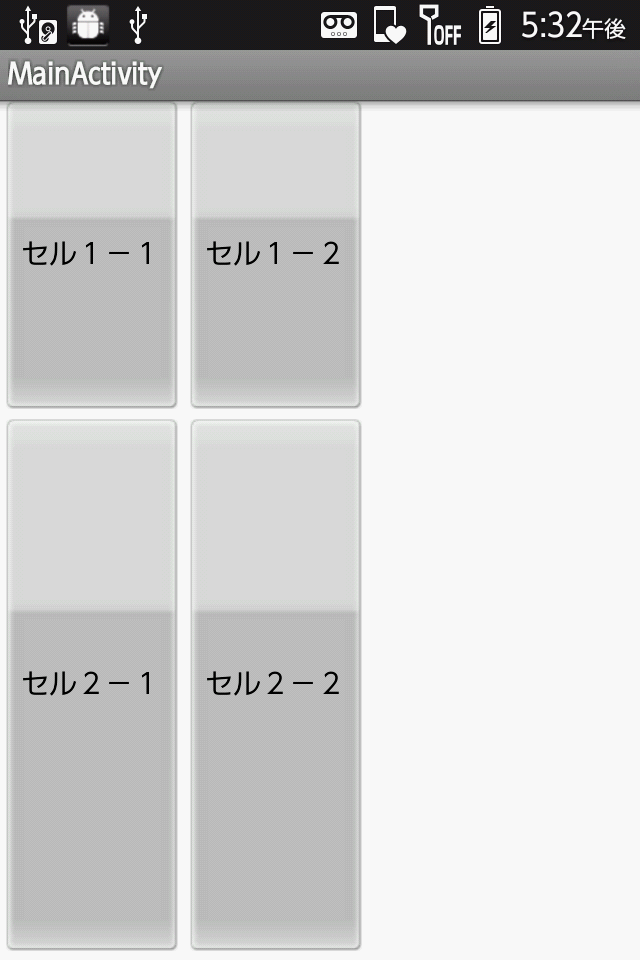AndroidでTableLayoutを動的に作成し、セル(行)の高さをウェイトを指定します。
【手順1】
1.「Androidプロジェクトの作成・実行方法(バージョン別一覧)」のAndroidプロジェクトの作成手順で、「AndroidSample36-007-TableLayoutDynamicHeightWeight」といプロジェクトを作成。
※プロジェクトの設定は以下の通り。
※他の項目は任意。
| 項目名 | 項目に設定する値 |
| アプリケーション名(Application Name) | com.example.androidsample36_007 |
| プロジェクト名(Project Name) | AndroidSample36-007-TableLayoutDynamicHeightWeight |
| パッケージ名(Package Name) | com.example.androidsample36_007 |
| Build SDK | API 8 |
| Minimum Required SDK | API 8 |
【手順2】
1.「AndroidManifest.xml」は以下の通り。
<?xml version="1.0" encoding="utf-8"?>
<manifest xmlns:android="http://schemas.android.com/apk/res/android"
package="com.example.androidsample36_007"
android:versionCode="1"
android:versionName="1.0" >
<uses-sdk
android:minSdkVersion="8"
android:targetSdkVersion="17" />
<application
android:allowBackup="true"
android:icon="@drawable/ic_launcher"
android:label="@string/app_name"
android:theme="@style/AppTheme" >
<activity
android:name="com.example.androidsample36_007.MainActivity"
android:label="@string/title_activity_main" >
<intent-filter>
<action android:name="android.intent.action.MAIN" />
<category android:name="android.intent.category.LAUNCHER" />
</intent-filter>
</activity>
</application>
</manifest>
2.「Ctrl+Shift+F」を押し、コードをフォーマッティング。3.「Ctrl+S」を押し、ファイルを保存。
【手順3】
1.「res/layout/activity_main.xml」は以下の通り。
<TableLayout xmlns:android="http://schemas.android.com/apk/res/android"
android:id="@+id/tableLayout"
android:layout_width="match_parent"
android:layout_height="match_parent" >
</TableLayout>
2.「Ctrl+Shift+F」を押し、コードをフォーマッティング。3.「Ctrl+S」を押し、ファイルを保存。
【手順4】
1.「src/com/example/androidsample36_007/MainActivity.java」は以下の通り。
package com.example.androidsample36_007;
import android.app.Activity;
import android.os.Bundle;
import android.view.ViewGroup.LayoutParams;
import android.widget.Button;
import android.widget.TableLayout;
import android.widget.TableRow;
public class MainActivity extends Activity {
@Override
protected void onCreate(Bundle savedInstanceState) {
super.onCreate(savedInstanceState);
setContentView(R.layout.activity_main);
initTableLayout();
}
private void initTableLayout() {
TableLayout tableLayout = (TableLayout) findViewById(R.id.tableLayout);
TableRow tableRow1 = new TableRow(this);
tableLayout.addView(tableRow1, new TableLayout.LayoutParams(LayoutParams.MATCH_PARENT, LayoutParams.MATCH_PARENT, 1));
tableRow1.addView(createButton("セル1-1"), new TableRow.LayoutParams(LayoutParams.MATCH_PARENT, LayoutParams.MATCH_PARENT));
tableRow1.addView(createButton("セル1-2"), new TableRow.LayoutParams(LayoutParams.MATCH_PARENT, LayoutParams.MATCH_PARENT));
TableRow tableRow2 = new TableRow(this);
tableLayout.addView(tableRow2, new TableLayout.LayoutParams(LayoutParams.MATCH_PARENT, LayoutParams.MATCH_PARENT, 2));
tableRow2.addView(createButton("セル2-1"), new TableRow.LayoutParams(LayoutParams.MATCH_PARENT, LayoutParams.MATCH_PARENT));
tableRow2.addView(createButton("セル2-2"), new TableRow.LayoutParams(LayoutParams.MATCH_PARENT, LayoutParams.MATCH_PARENT));
}
private Button createButton(String text) {
Button button = new Button(this);
button.setText(text);
return button;
}
}
2.「Ctrl+Shift+F」を押し、コードをフォーマッティング。3.「Ctrl+S」を押し、ファイルを保存。
【手順5】
1.「Androidプロジェクトの作成・実行方法(バージョン別一覧)」のAndroidプロジェクトの実行手順で、実行。
【手順6】
1.以下の様に表示されれば成功です。
以上です。

0 件のコメント:
コメントを投稿
注: コメントを投稿できるのは、このブログのメンバーだけです。